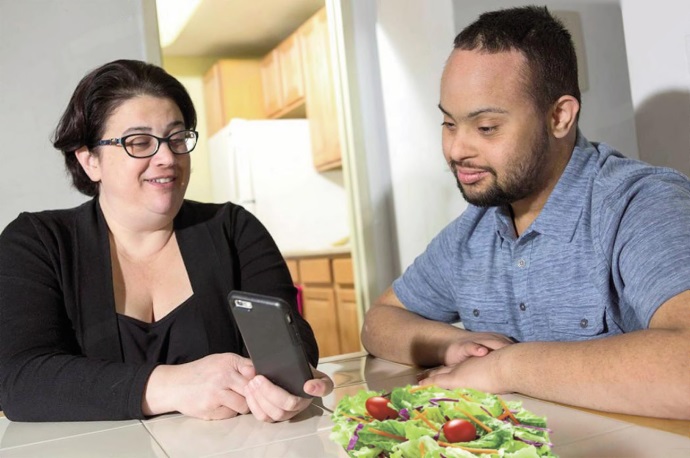When provided with nutrition education, individuals with I/DD can learn to reduce their risk of chronic diseases, fuel their bodies with essential nutrients and become empowered to make their own healthy choices.
Ellyn Satter, Registered Dietitian and well-known authority on child feeding states in her "Division of Responsibility in Feeding" that parents are responsible for the "what, where and when" of feeding. They are responsible for choosing what foods are offered, when they are offered and where the food is eaten. Children are responsible for how much of the food is eaten and whether the food is eaten.1 As children grow up, they learn to be responsible for choosing what to eat. A common issue in the adult I/DD community is balancing an individual's food preferences with food choices that are best for their health needs, which may not coincide. Fortunately, we do not have to choose between healthy foods a person is unhappy with or conceding to ice cream for dinner.
Providing nutrition education for people with I/DD that is easily communicated, memorable and most important, fun, are keys to effective learning. Nutrition activities can be done at home with family or in congregate settings. Replacing wordy handouts with colorful picture references, keeping nutrition messages brief, revisiting topics often and building on prior concepts make nutrition information easier to remember. Rather than providing guidance from a distance, nutrition education becomes exciting with hands-on activities like cooking and games that motivate individuals to take care of themselves and reinforces nutrition recommendations. These types of activities should be tailored for the age level and modified for any specialized diets and feeding instructions given to you by your health professional.
Research has shown that adding pictures to written or spoken health education materials increases the students' attention, comprehension, recall and adherence to health recommendations. Pictures are especially helpful for those with differing literacy.2
Creating handouts with pictures of healthy foods from a favorite local convenience store, restaurant or grocery can help individuals recognize healthy options available in their familiar environment. Handouts highlighting food choices from local stores allow choices to be made ahead of time and can prevent frustration or challenging behaviors as new foods and eating habits are introduced. If someone has difficulty incorporating fruits or vegetables into their diet, a pictorial handout can help encourage them to work toward the recommended amount per day.
Enjoyable participatory exercises relying on pictures include slide show grocery store tours, displaying pictures of local restaurants and menus, and watching the evolution of a food starting with where it is grown, then packaged and cooked. Group discussions can be held on healthy food choices in different sections of the grocery store, what the best menu items are from local restaurants and the different ways certain food ingredients are packed and utilized. These more complicated activities may be suggestions for a day program or may inspire similar home activities. Many grocery stores now have on staff dietitians that are available to do free nutrition presentations for programs in their area.
Keeping nutrition messaging simple is a key to retention and adherence in all populations. Using Myplate or the "plate method" helps individuals understand a balanced diet to provide themselves proper proportions of fruits, vegetables, grains, dairy and protein throughout the day". Myplate, the current food guide published by USDA's Center for Nutrition Policy and Promotion, provides a printable graphic demonstrating a balanced plate comprised of approximately 20% protein, 30% grain, 20% fruit and 30% vegetables with a serving of dairy (or fortified non-dairy alternative) on the side. Myplate.gov includes nutrition recommendations for every stage of life, making it a rich resource for all age groups. Browsing the food group gallery, individuals can learn which foods fit in the
main food groups. Using blank Myplate templates, individuals can draw, write or paste pictures of the foods they like in the correct area of the plate for each food group. When an individual favors or avoids certain food groups on their exercise sheets, that can be noted and can help guide nutrition goals toward a balanced diet.3

HEALTHY HABITS: A common issue in the adult I/DD community is balancing an individual's food preferences with food choices that are best for their health needs, which may not coincide.
Additional resources that have been very useful in this setting are Myplate catch phrases such as "Make Half your Plate Fruits and Vegetables", "Think About Your Drink" or "Try Whole Grains." These sayings help individuals remember to avoid sugary beverages or to try whole-grain bread or pasta instead of the white flour varieties. 3
For individuals that have specific and sometimes limited diets due to sensory preferences or anxiety with changes in routine, exposure to a new food in a fun way can help increase the likelihood of trying new foods. Myplate.gov offers Grocery Store Bingo Cards where a player can search the aisles looking for specific healthy foods.3 Additionally, online templates allow for creating custom bingo cards using individualized bingo squares with nutrition goals such as "Had a Fruit for Snack" or "No Sweets Today".